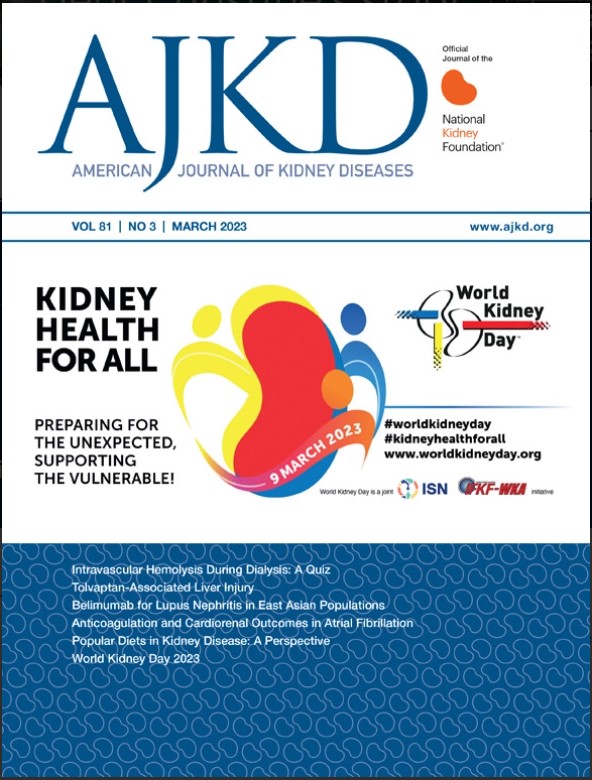Development and Evaluation of Machine Learning Models to Predict the Risk of Major Cardiac Events and Death for People With Kidney Failure Having Non-Cardiac Surgery.
IF 8.2
1区 医学
Q1 UROLOGY & NEPHROLOGY
引用次数: 0
Abstract
RATIONALE & OBJECTIVE People with kidney failure undergoing non-cardiac surgery face an elevated risk of cardiovascular events and mortality. Existing risk prediction tools for perioperative events are either inaccurate in this population or include many variables that may complicate implementation. We developed and evaluated the performance of simplified machine-learning models for major cardiac events and mortality within 30 days after non-cardiac surgery in patients with kidney failure in Alberta and Manitoba, Canada. STUDY DESIGN Data from Manitoba was split into training (70%), validation (15%), and testing (15%) sets. The training set was used for hyperparameter tuning and model training, the validation set for feature selection and evaluating model performance, and the testing set for final model performance. External evaluation was performed in a cohort from Alberta. SETTING & PARTICIPANTS We included Manitoban adults (≥ 18 years) with kidney failure (eGFR < 15 mL/min/1.73m2 or on maintenance dialysis) undergoing non-cardiac surgery (2007-2019), with evaluation data on adults from Alberta (2005-2019). PREDICTORS Variables included sex, age, surgery type and setting, kidney failure type, chronic conditions, and preoperative laboratory values (albumin and hemoglobin). OUTCOME Composite of acute myocardial infarction, cardiac arrest, ventricular arrhythmia, and all-cause mortality within 30 days of surgery. ANALYTICAL APPROACH Model performance was evaluated using Area Under the Receiver Operating Characteristic Curve (AUC-ROC), Area Under the Precision-Recall Curve (AUC-PR), and calibration. The final XGBoost and random forest models were externally validated using Alberta data. RESULTS Among 4,175 participants (12,082 surgeries), 569 outcomes (5%) were observed. The parsimonious XGBoost model (8 features) showed an AUC-ROC of 0.861 and AUC-PR of 0.304, and the parsimonious random forest model (20 features) estimated an AUC-ROC of 0.863 and AUC-PR of 0.332 in the testing cohort. External validation in Alberta showed similar performance with good calibration. LIMITATIONS Lack of external validation outside Canada. CONCLUSION Our machine learning models were accurate and had improved parsimony over existing regression-based tools. Future work should test these models in other populations and compare them with regression-based models, in addition to assessing the value of these tools for informing risk-guided perioperative care.机器学习模型的开发和评估,以预测非心脏手术肾衰竭患者的主要心脏事件和死亡风险。
理由与目的接受非心脏手术的肾衰竭患者面临心血管事件和死亡率升高的风险。现有的围手术期事件风险预测工具要么在这一人群中不准确,要么包含许多可能使实施复杂化的变量。我们开发并评估了简化的机器学习模型的性能,该模型适用于加拿大阿尔伯塔省和马尼托巴省肾衰竭患者非心脏手术后30天内的主要心脏事件和死亡率。研究设计来自马尼托巴省的数据被分为训练组(70%)、验证组(15%)和测试组(15%)。训练集用于超参数调优和模型训练,验证集用于特征选择和评估模型性能,测试集用于最终模型性能。外部评价是在阿尔伯塔的一个队列中进行的。环境和参与者我们纳入了曼尼托巴省(≥18岁)接受非心脏手术的肾功能衰竭(eGFR < 15 mL/min/1.73m2或维护性透析)的成年人(2007-2019),评估数据来自艾伯塔省(2005-2019)。预测变量包括性别、年龄、手术类型和手术地点、肾衰竭类型、慢性疾病和术前实验室值(白蛋白和血红蛋白)。结果:手术后30天内急性心肌梗死、心脏骤停、室性心律失常和全因死亡率的综合。分析方法采用受试者工作特征曲线下面积(AUC-ROC)、精确度-召回率曲线下面积(AUC-PR)和校准来评估模型的性能。最终的XGBoost和随机森林模型使用Alberta数据进行外部验证。结果在4175名参与者(12082例手术)中,观察到569例(5%)的结果。精简XGBoost模型(8个特征)的AUC-ROC为0.861,AUC-PR为0.304,精简随机森林模型(20个特征)的AUC-ROC为0.863,AUC-PR为0.332。在艾伯塔省的外部验证显示出类似的性能与良好的校准。加拿大以外的外部验证的限制。结论我们的机器学习模型是准确的,并且比现有的基于回归的工具更简洁。未来的工作应该在其他人群中测试这些模型,并将其与基于回归的模型进行比较,此外还要评估这些工具对风险指导围手术期护理的价值。
本文章由计算机程序翻译,如有差异,请以英文原文为准。
求助全文
约1分钟内获得全文
求助全文
来源期刊

American Journal of Kidney Diseases
医学-泌尿学与肾脏学
CiteScore
20.40
自引率
2.30%
发文量
732
审稿时长
3-8 weeks
期刊介绍:
The American Journal of Kidney Diseases (AJKD), the National Kidney Foundation's official journal, is globally recognized for its leadership in clinical nephrology content. Monthly, AJKD publishes original investigations on kidney diseases, hypertension, dialysis therapies, and kidney transplantation. Rigorous peer-review, statistical scrutiny, and a structured format characterize the publication process. Each issue includes case reports unveiling new diseases and potential therapeutic strategies.
 求助内容:
求助内容: 应助结果提醒方式:
应助结果提醒方式:


